Themed collection Tribology

Tight-binding quantum chemical molecular dynamics simulations of the low friction mechanism of fluorine-terminated diamond-like carbon films
The strong repulsive interactions at the interface of F-terminated DLC produce its low friction properties under a high contact pressure.

RSC Adv., 2014,4, 33739-33748
https://doi.org/10.1039/C4RA04065A
Halogen-free pyrrolidinium bis(mandelato)borate ionic liquids: some physicochemical properties and lubrication performance as additives to polyethylene glycol
Friction coefficients for a pyrrolidinium orthoborate ionic liquid as 3 wt% additive in PEG, neat PEG and 5W40.
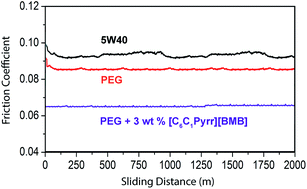
RSC Adv., 2014,4, 30617-30623
https://doi.org/10.1039/C4RA02551B
Surface properties of AlCuFeB coatings with focus on resolving tribological issues of nanoimprint lithography
Study of individually prepared AlCuFeB coatings was performed with focus on surface properties desired in nano imprint lithography.

RSC Adv., 2014,4, 29474-29478
https://doi.org/10.1039/C4RA01888E
Effects of surface compliance and relaxation on the frictional properties of lamellar materials
We present experimental and theoretical considerations explaining the phenomenon of increasing friction under decreasing normal loads observed in atomic force microscopy scans of mildly oxidized surfaces of lamellar materials.
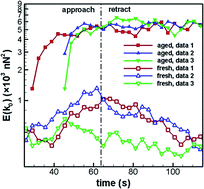
RSC Adv., 2014,4, 26721-26728
https://doi.org/10.1039/C4RA03810J
Synthesis of polymeric lubricating films directly at the sliding interface via mechanochemical reactions of allyl alcohols adsorbed from the vapor phase
Friction initially occurs in a vapor environment, during which a triboproduct is formed. This triboproduct lubricates in absence of the vapor for over 30 000 reciprocating cycles.
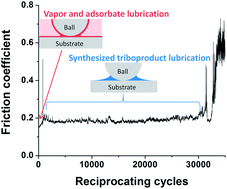
RSC Adv., 2014,4, 26081-26086
https://doi.org/10.1039/C4RA02283A
Hierarchical multiple peeling simulations
We model hierarchical multiple peeling through finite element simulations, quantifying how hierarchy optimizes the strength of the bioinspired attachment.
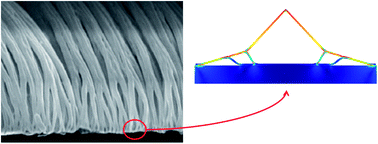
RSC Adv., 2014,4, 25447-25452
https://doi.org/10.1039/C4RA03459G
Tribological study of hydrolytically stable S-containing alkyl phenylboric esters as lubricant additives
S-containing alkyl phenylboric esters with excellent hydrolytic stability used as lubricant additives.

RSC Adv., 2014,4, 25118-25126
https://doi.org/10.1039/C4RA01672F
Shear and thermal effects in boundary film formation during sliding
The mechanisms for boundary film formation are described for an interface at thermal equilibrium showing thermally dominated growth mechanisms at high temperatures and shear-induced processes at ambient temperatures.
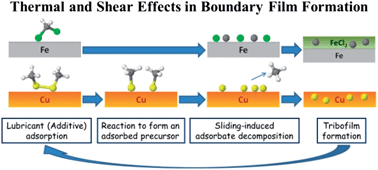
RSC Adv., 2014,4, 24059-24066
https://doi.org/10.1039/C4RA03519D
Total internal reflection Raman spectroscopy of poly(alpha-olefin) oils in a lubricated contact
A novel total internal reflection (TIR) Raman tribometer has been used to explore the physiochemical changes associated with shear-thinning in synthetic base oil.
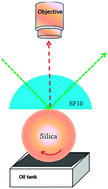
RSC Adv., 2014,4, 22205-22213
https://doi.org/10.1039/C4RA02261K
Impact of chain morphology on the lubricity of surface-grafted polysaccharides
The impact of brush-like structure and disorder on the lubricating ability of dextran chains at low and high loads has been investigated by means of AFM.
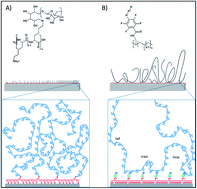
RSC Adv., 2014,4, 21497-21503
https://doi.org/10.1039/C4RA01087F
WS2 nanoparticles – potential replacement for ZDDP and friction modifier additives
WS2 nanoparticles possess remarkable tribological and physicochemical properties, which recommend them as potential candidates for replacing problematic additives.
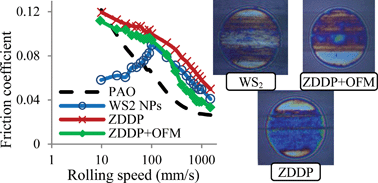
RSC Adv., 2014,4, 21238-21245
https://doi.org/10.1039/C4RA01795A
The tribological behaviour and tribochemical study of B–N type borate esters in rapeseed oil—compound versus salt
The boundary films formed by compound or salt are similar and mainly composed of B2O3.
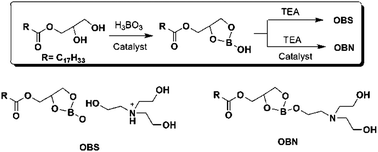
RSC Adv., 2014,4, 20940-20947
https://doi.org/10.1039/C4RA02267J
The effect of boundary slip on elastohydrodynamic lubrication
Pressure-induced boundary slip in elastohydrodynamic lubrication, on application of an oleophobic coating, is measured by photobleached-fluorescence imaging velocimetry.
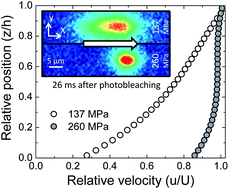
RSC Adv., 2014,4, 20821-20829
https://doi.org/10.1039/C4RA01714E
Excellent friction-reducing performance of superhydrophobic steel surface in dry sliding
Superhydrophobic micro/nano-engineered steel surfaces with friction-reducing properties were fabricated by the combination of chemical etching and stearic acid coating.
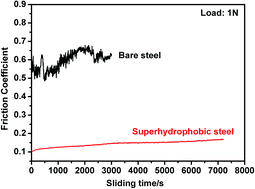
RSC Adv., 2014,4, 20548-20553
https://doi.org/10.1039/C3RA47496H
Development of a BiotriboPOD testing methodology for the wear evaluation of orthopaedic biomaterials
A Biotribo-POD apparatus has been developed, which provides an efficient and reliable methodology for the wear evaluation of orthopaedic biomaterials.
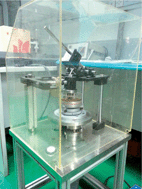
RSC Adv., 2014,4, 19987-19991
https://doi.org/10.1039/C4RA01743A
Ionic liquids from amino acids: fully green fluid lubricants for various surface contacts
Five ionic liquids have been prepared by simply neutralizing [N4444][OH] with amino acids, which exhibit excellent physicochemical and tribological properties.
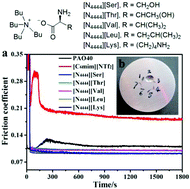
RSC Adv., 2014,4, 19396-19402
https://doi.org/10.1039/C3RA47644H
Study on wear behaviour and wear model of nitrile butadiene rubber under water lubricated conditions
The main wear mechanism between the NBR pins and the 1Cr18Ni9Ti stainless steel rubbing pairs is severe adhesion tearing wear under the water-lubricated condition.

RSC Adv., 2014,4, 19034-19042
https://doi.org/10.1039/C4RA01703J
Friction of aromatic thiol monolayers on silver: SFA and AFM studies of adhesive and non-adhesive contacts
(a) Friction coefficients and (b) critical shear stresses of thiol monolayers on silver, measured with SFA (○) and AFM (red circles).
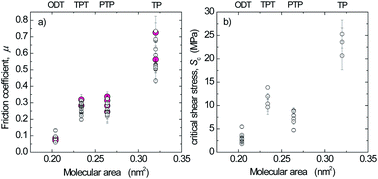
RSC Adv., 2014,4, 18801-18810
https://doi.org/10.1039/C4RA01803F
The role of substrate interactions in the modification of surface forces by self-assembled monolayers
Detailed pressure and strain mapping of atomistic contact simulations elucidate the mechanical and tribochemical mechanisms of surface force modification with SAMs.
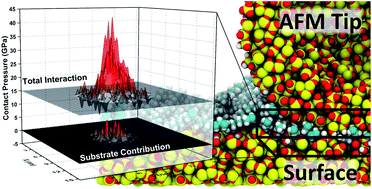
RSC Adv., 2014,4, 16803-16812
https://doi.org/10.1039/C4RA01427H
Tribology study of lanthanum-treated graphene oxide thin film on silicon substrate
Low friction coefficient and wear rate of components are crucial for nano-electromechanical-systems.
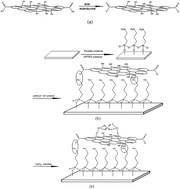
RSC Adv., 2014,4, 15937-15944
https://doi.org/10.1039/C4RA00550C
Tribological properties of naphthyl phenyl diphosphates as antiwear additive in polyalkylene glycol and polyurea grease for steel/steel contacts at elevated temperature
Naphthyl phenyl diphosphates as high-performance antiwear additive in polyalkylene glycol and polyurea grease for steel/steel contacts at 200 °C.
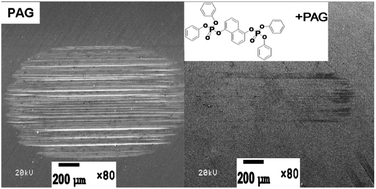
RSC Adv., 2014,4, 6074-6082
https://doi.org/10.1039/C3RA46591H
The impact of organic friction modifiers on engine oil tribofilms
Engine oil tribofilms are generated by the simultaneous interaction of organic friction modifiers and ZDDP antiwear additives with the wear track.
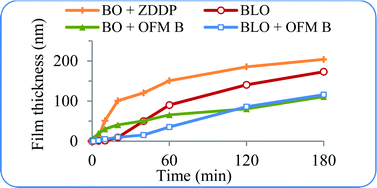
RSC Adv., 2014,4, 4278-4285
https://doi.org/10.1039/C3RA46403B
About this collection
We are pleased to present this RSC Advances themed collection on Tribology. The field of tribology is where chemistry and mechanics meet. It represents a challenging cross-disciplinary arena focusing on the widely recognized problems associated with friction, adhesion and wear that impact a range of materials systems, from machined engine parts, to spacecraft and satellites, to medical implants. Control of friction and wear is also a vital issue for the world economy, playing a major role in energy efficiency. The articles in this collection cover the spectrum of tribology from applied to fundamental, including computational studies. We hope that you find the work presented here an inspiring snapshot of the many fascinating problems and challenges that remain to be explored.
James D. Batteas, Texas A&M University
Graham J. Leggett, University of Sheffield
Scott S. Perry, University of Florida